CAREER: MIMO-Based Blind Interference Cancellation for Wireless Networking
Project Information
Award numbers: NSF 2100112 (previously, NSF 1846105)
Project period: 8/16/2020 – 3/31/2026
Principal investigator: Dr. Huacheng Zeng
Graduate student:
Kunzhe Song (Ph.D. student)
Qijun Wang (Ph.D. student)
Bowei Zhang (Ph.D. student)
Peihao Yan (Ph.D. student)
Brendan Bushbaker (Undergraduate student)
Shichen Zhang (Ph.D. student)
Pedram Kheirkhah Sangdeh (Ph.D. student)
Hossein Pirayesh (Ph.D. student)
Project Overview
Interference is a fundamental problem in wireless networks. Although interference has been intensively studied in the past two decades and a large body of research results have been produced in both information and communication theories, most of existing interference management techniques are limited to cooperative networks where each individual network device has some knowledge about interference (e.g., waveform and frame format). Very limited progress has been made so far in the design of practical solutions to mitigating unknown yet strong interference for wireless devices in real-world telecommunications networks.
The goal of this project is to develop blind interference cancellation (BIC) techniques that can tame unknown interference by leveraging recent advances in MIMO technology, and use the BIC techniques to advance networking solutions for 5G communications. The proposed research will be carried out through three inter-dependent research thrusts: 1) develop generic MIMO-based BIC framework that enables a wireless receiver to decode its signal in the face of unknown (strong) interference; 2) develop transparent spectrum sharing schemes that allow heterogeneous wireless networks to use the same spectrum at the same time; and 3) integrate a small-cell base station into a multi-antenna Wi-Fi access point (AP). This project will take advantage of recent advances in communications theory, algorithm and protocol design, and cross-layer optimization to cope with unknown interference. The algorithms and protocols developed in this project are complemented by a system-level implementation and experimentation effort aimed at guaranteeing that the technologies developed are suitable for deployment in real-world wireless systems.
Publications
RadSee: See your handwriting through walls using FMCW radar [PDF]
S. Zhang*, Q. Wang*, M. Gan*, Z. Cao, and H. Zeng
Network and Distributed System Security (NDSS) Symposium, 2025. [Acceptance rate: 19.8%]
SiWiS: Fine-grained human detection using single Wi-Fi device [PDF]
K. Song*, Q. Wang*, S. Zhang*, and H. Zeng,
ACM MobiCom, 2024.
Is driver on phone call? Mobile device localization using cellular signal [PDF]
S. Zhang*, H. Zeng, and Y. T. Hou
IEEE Journal on Selected Areas in Communications, 2024.
TBP: Temporal beam prediction for mobile millimeter-wave networks [PDF]
S. Zhang*, Q. Yan, T. Li, L. Xiao, and H. Zeng,
IEEE Internet of Things Journal, 2024.
mReader: Concurrent UHF RFID tag reading [PDF]
H. Pirayesh*, S. Zhang*, and H. Zeng,
ACM MobiHoc 2023. [Acceptance rate: 21.9%]
Realizing uplink MU-MIMO communication in mmWave WLANs: Bayesian optimization and asynchronous transmission [PDF]
S. Zhang*, B. Ji, K. Zeng, and H. Zeng,
IEEE Infocom 2023. [Acceptance rate: 19.2%]
CF4FL: A communication framework for federated learning in transportation systems [PDF]
P. Kheirkhah Sangdeh*, C. Li, H. Pirayesh*, S. Zhang*, H. Zeng, and Y. T. Hou,
IEEE Transactions on Wireless Communications.
MaLoRaGW: Multi-user MIMO transmission for LoRa [PDF]
H. Pirayesh*, S. Zhang*, P. Kheirkhah Sangdeh*, and H. Zeng,
ACM SenSys 2022. [Acceptance rate: 24.8%]
AuthIoT: A transferable wireless authentication scheme for IoT devices without input interface [PDF]
S. Zhang*, P. Kheirkhah Sangdeh*, H. Pirayesh*, H. Zeng, Q. Yan, and K. Zeng,
IEEE Internet of Things Journal, 2022.
Jamming attacks and anti-jamming strategies in wireless networks: A comprehensive survey [PDF]
H. Pirayesh and H. Zeng,
IEEE Communications Surveys and Tutorials, 2022.
DeepMux: Deep-learning-based channel sounding and resource allocation for IEEE 802.11ax [PDF]
P. Kheirkhah Sangdeh* and H. Zeng
IEEE Journal on Selected Areas in Communications, vol. 39, no. 8, pp. 2333–2346, June 2021.
JammingBird: Jamming-resilient communications for vehicular ad hoc networks [PDF]
H. Pirayesh*, P. Kheirkhah Sangdeh*, S. Zhang*, Q. Yan, and H. Zeng
IEEE SECON 2021.
UD-MIMO: Uplink distributed MIMO for wireless LANs [PDF]
H. Pirayesh*, P. Kheirkhah Sangdeh*, Q. Yan, and H. Zeng
IEEE SECON 2021. [Best Paper Award]
VehCom: Delay-Guaranteed Message Broadcast for Large-Scale Vehicular Networks [PDF]
H. Zeng, P. Kheirkhah Sangdeh*, H. Pirayesh*, and A. Quadri*
IEEE Transactions on Wireless Communications, 2021.
Securing ZigBee communications against constant jamming attack using neural network [PDF]
H. Pirayesh*, P. Kheirkhah Sangdeh*, and H. Zeng,
IEEE Internet of Things Journal, 2020.
LB-SciFi: Online learning-based channel feedback for MU-MIMO in wireless LANs [PDF]
P. Kheirkhah Sangdeh*, H. Pirayesh*, A. Mobiny, and H. Zeng,
IEEE ICNP, 2020. [Acceptance rate: 16.8%]
A practical spectrum sharing scheme for cognitive radio networks: Design and experiments [PDF]
P. Kheirkhah Sangdeh*, H. Pirayesh*, A. Quadri*, and H. Zeng,
IEEE/ACM Transactions on Networking, vol. 28, no. 4, pp. 1818-1831, Aug. 2020.
Coexistence of Wi-Fi and IoT Communications in WLANs [PDF]
H. Pirayesh*, P. Kheirkhah Sangdeh*, and H. Zeng,
IEEE Internet of Things Journal, vol. 7, no. 8, pp. 7495-7505, Aug. 2020.
TCCI: Taming Co-Channel Interference for Wireless LANs [PDF]
A. Quadri*, H. Pirayesh*, P. Kheirkhah Sangdeh*, and H. Zeng,
ACM MobiHoc, 2020. [Acceptance rate: 15%]
A practical downlink NOMA scheme for wireless LANs [PDF]
P. Kheirkhah Sangdeh*, H. Pirayesh*, Q. Yan, K. Zeng, W. Lou, and H. Zeng,
IEEE Transactions on Communications, vol. 68, no. 4, pp. 2236–2250, Jan 2020.
Research Activities and Outcomes
Online Diffusion Model for Collaborative Inter-Cell Interference Management in O-RAN
Open Radio Access Network (O-RAN) is a key architectural paradigm for 5G and beyond cellular networks, enabling the adoption of intelligent and efficient resource management solutions. Meanwhile, diffusion models have demonstrated remarkable capabilities in image and video generation, making them attractive for network optimization tasks. In this paper, we propose xDiff, a diffusion-based reinforcement learning (RL) framework for inter-cell interference management (ICIM) in O-RAN. We first formulate ICIM as a resource allocation optimization problem aimed at maximizing a user-defined reward function, and then develop an online learning solution by integrating a diffusion model into an RL framework for near-real-time policy generation. Particularly, we introduce a novel metric, preference values, as the policy representation to enable efficient policy-guided resource allocation within O-RAN distributed units (DUs). We implement xDiff on a 5G testbed consisting of three cells and a set of smartphones in two small-cell scenarios. Experimental results demonstrate that xDiff outperforms state-of-the-art ICIM approaches, highlighting the potential of diffusion models for online optimization of O-RAN.
RadSee: See Your Handwriting Through Walls Using FMCW Radar
This paper aims to design and implement a radio device capable of detecting a person's handwriting through a wall. While there is extensive research on radio frequency (RF)-based human activity recognition, this task is particularly challenging due to interference from surrounding objects and the small-scale movement of handwriting. To address these challenges, we present RadSee—a 6 GHz frequency-modulated continuous wave (FMCW) radar system designed for detecting handwriting content behind a wall. RadSee is realized through a joint hardware and software design. On the hardware side, RadSee features a 6 GHz FMCW radar device equipped with two custom-designed, high-gain patch antennas. On the software side, RadSee incorporates a robust algorithm to mitigate interference from multipath and surrounding objects. As a result, RadSee can detect millimeter-level handwriting movements and recognize most letters based on their unique phase patterns. Particularly, it is resilient to interference from other moving objects and in-band radio devices. We have built a prototype of RadSee and evaluated its performance in various scenarios. Extensive experimental results demonstrate that RadSee achieves 75% letter recognition accuracy when the subjects write 62 random letters, and 87% word recognition accuracy when they write articles.
Achieving anti-jamming 5G mmWave communications: Design and Experiments
Reliable millimeter-wave (mmWave) communications are critical for many applications such as autonomous driving, remote surgery, and military operations. However, maintaining the reliability of mmWave communications is challenging in scenarios where mmWave networks suffer from unintentional interference from legitimate devices or intentional interference from malicious parties. In this paper, we present a joint analog and digital beamforming scheme for a mmWave receiver to decode its data packets in the presence of jamming signals. The beamforming scheme comprises two key techniques: i) an online-learning Bayesian Optimization framework for analog beamforming (ABF); and ii) a Modified Minimum Mean Square Error (M-MMSE) detector for digital beamforming (DBF). The combination of these techniques enables a receiver to suppress jamming signals in both analog and digital domain, making it capable of decoding data packets in the presence of jamming signals. We have built a prototype of the proposed receiver on a mmWave (28 GHz) testbed and extensively evaluated its performance in four different scenarios. Experimental results confirm the effectiveness of the two beamforming techniques; particularly, when a jammer emits 10 dB stronger power than a mmWave transmitter, our receiver achieves 73.1% throughput of jamming-free case.

Achieving concurrent UHF RFID tag reading via interference mitigation
UHF RFID tags have been widely used for contactless inventory and tracking applications. One fundamental problem with RFID readers is their limited tag reading rate. Existing RFID readers (e.g., Impinj Speedway) can read about 35 tags per second in a read zone, which is far from enough for many applications. In this project, we present the first-of-its-kind RFID reader (mReader), which borrows the idea of multi-user MIMO (MU-MIMO) from cellular networks to enable concurrent multi-tag reading in passive RFID systems. mReader is equipped with multiple antennas for implicit beamforming in downlink transmissions. It is enabled by three key techniques: uplink collision recovery, transition-based channel estimation, and zero-overhead channel calibration. In addition, mReader employs a Q-value adaptation algorithm for medium access control to maximize its tag reading rate. We have built a prototype of mReader on USRP X310 and demonstrated for the first time that a two-antenna reader can read two commercial off-the-shelf (COTS) tags simultaneously. Numerical results further show that mReader can improve the tag reading rate by 45% compared to existing RFID readers.
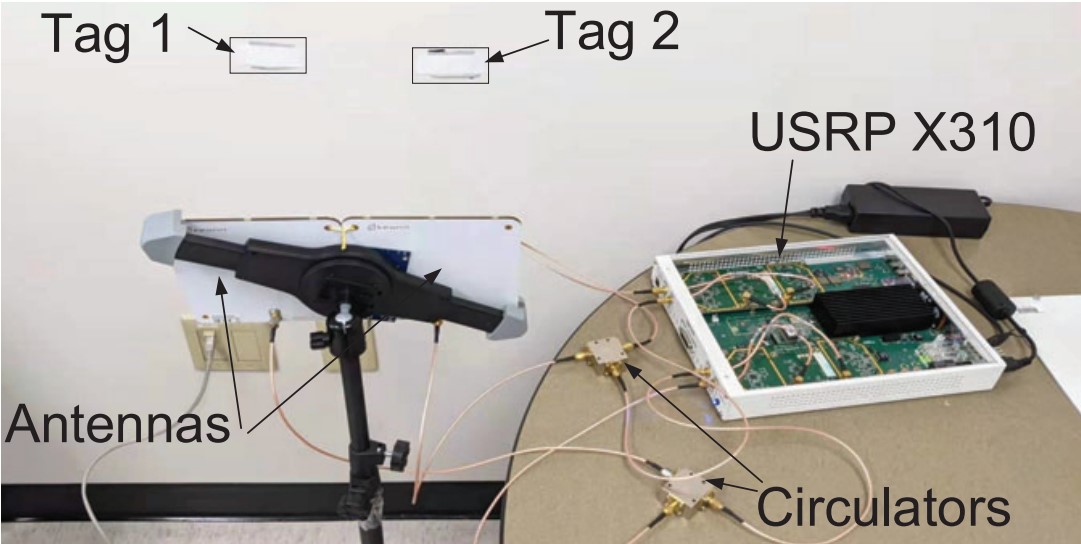
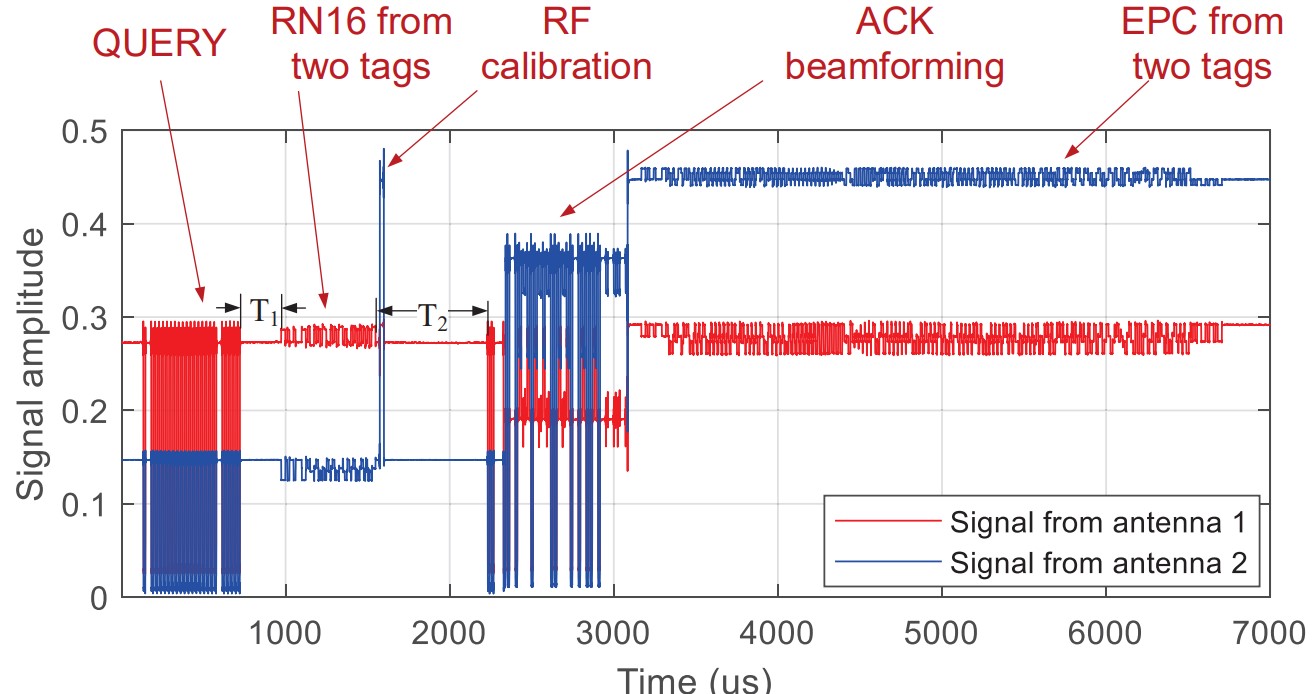


Multi-User MIMO Transmission for Long Range (LoRa) Wireless Communications
LoRa has emerged as a key wireless communication technology for a gateway to provide geographically-distributed IoT devices with low-rate, long-range connections. In this work, we present MaLoRaGW, the first-of-its-kind Multi-antenna LoRa GateWay that enables multi-user MIMO (MU-MIMO) LoRa communications in both uplink and downlink. MaLoRaGW was inspired by the success of MU-MIMO in cellular and Wi-Fi networks. The key component of MaLoRaGW is a joint baseband PHY design for uplink packet detection and downlink beamforming. Its innovation lies in three modules: spatial signal projection, accurate channel estimation, and implicit beamforming, all of which reside only in a LoRa gateway and require no modification on LoRa client devices. We have built a prototype of two-antenna MaLoRaGW on a USRP device and extensively evaluated its performance with commercial LoRa dongles in three scenarios: lab, office building, and university campus. Our experimental results show that, compared to the state-of-the-art, the two-antenna MaLoRaGW increases uplink throughput by 10% and downlink throughput by 95%.
A Bayesian optimization Approach to Realizing uplink MU-MIMO communication in mmWave WLANs
With the rapid proliferation of mobile devices, the marriage of millimeter-wave (mmWave) and MIMO technologies is a natural trend to meet the communication demand of data-hungry applications. Following this trend, mmWave multiuser MIMO (MU-MIMO) has been standardized by the IEEE 802.11ay for its downlink to achieve multi-Gbps data rate. Yet, its uplink counterpart has not been well studied, and its way to wireless local area networks (WLANs) remains unclear. In this work, we presented a practical uplink MU-MIMO mmWave communication (UMMC) scheme for WLANs. UMMC has two key components: (i) an efficient Bayesian optimization (BayOpt) framework for joint beam search over multiple directional antennas, and (ii) a new MU-MIMO detector that can decode asynchronous data packets from multiple user devices. We have built a prototype of UMMC on a mmWave testbed and evaluated its performance through a blend of over-the-air experiments and extensive simulations. Experimental and simulation results confirm the efficiency of UMMC in practical network settings.
A Communication Framework for Federated Learning in Transportation Systems
Federated Learning (FL) is a promising technique to enhance the safety and efficiency of intelligent transportation systems. While FL has been extensively studied, the communication and networking challenges related to the operations of FL in dynamic yet dense vehicular networks remain under-explored. Limited storage and communication capacities of individual vehicles throttle the timely training of an FL model in distributed vehicular networks. In this work, we present a communication framework for FL (CF4FL) in transportation systems. CF4FL aims to accelerate the convergence of FL training process through the innovation of two complementary networking components: (i) a deadline-driven vehicle scheduler (DDVS), and (ii) a concurrent vehicle polling scheme (CVPS). DDVS identifies a subset of vehicles for local model training in each iteration of FL, with the aim of minimizing data loss while respecting the deadline constraints derived from vehicles’ storage, computation, and energy budgets. CVPS takes advantage of multiple antennas on an edge server to enable concurrent local model transmissions in dynamic vehicular networks, thereby reducing the airtime overhead of each FL iteration. We have evaluated CF4FL through a blend of experimentation and simulation. Trace-driven simulation shows that, compared to existing scheduling and transmission schemes, CF4FL reduces the convergence time of FL training by 39%.
A comprehensive survey of jamming attacks and anti-jamming strategies in wireless networks [PDF]
Although wireless technologies have significantly advanced in the past decades, most wireless networks are still vulnerable to radio jamming attacks due to the openness nature of wireless channels, and the progress in the design of jamming-resistant wireless networking systems remains limited. This stagnation can be attributed to the lack of practical physical-layer wireless technologies that can efficiently decode data packets in the presence of jamming attacks. We conducted a comprehensive survey on existing jamming attacks and anti-jamming strategies in wireless local area networks (WLANs), cellular networks, cognitive radio networks (CRNs), ZigBee networks, Bluetooth networks, vehicular networks, LoRa networks, RFID networks, GPS system, millimeterwave (mmWave) and learning-assisted wireless systems, with the objective of offering a full knowledge landscape of existing jamming and anti-jamming strategies and therefore stimulating more research efforts to secure wireless networks against jamming attacks. We also point out the key challenges in the design of jamming-resilient wireless networks and delineate the promising anti-jamming strategies to secure emerging wireless systems.
Efficient MIMO-based interference mitigation design for IEEE 802.11ax using deep learning [PDF]
We proposed DeepMux, a deep-learning-based MU-MIMO-OFDMA transmission scheme for 802.11ax networks. DeepMux mainly comprises two components: deep-learning-based channel sounding (DLCS) and deep-learning-based resource allocation (DLRA), both of which reside in access points (APs) and impose no computational/communication burden on Wi-Fi clients. DLCS reduces the airtime overhead of 802.11 protocols by leveraging the deep neural networks (DNNs). It uses uplink channels to train the DNNs for downlink channels, making the training process easy to implement. DLRA, as the second component, employs a DNN to solve the mixed-integer resource allocation problem, enabling an AP to obtain a near-optimal solution in polynomial time. We have built a wireless testbed to examine the performance of DeepMux in real-world environments. Our experimental results show that DeepMux reduces the sounding overhead by 62.0%-90.5% and increases the network throughput by 26.3%-43.6%.
Year 3: Enabling jamming-resilient communications in vehicular ad hoc networks [PDF]
Current data-driven intelligent transportation systems are reliant on IEEE 802.11p to collect and exchange information. Despite promising performance of IEEE 802.11p in providing low-latency communications, it is still vulnerable to jamming attacks due to the lack of a PHY-layer countermeasure technique in practice. In this work, we proposed JammingBird, a novel receiver design that tolerates strong constant jamming attacks. The enablers of JammingBird are two MIMO-based techniques: Jamming-resistant synchronizer and jamming suppressor. Collectively, these two new modules are able to detect, synchronize, and recover desired signals under jamming attacks, regardless of the PHY-layer technology employed by the jammers. We have implemented JammingBird on a vehicular testbed and conducted extensive experiments to evaluate its performance in three vehicular scenarios: Parking lots (0-15 mph), local traffic areas (25-45 mph), and highways (60-70 mph). Experimental results also show that JammingBird is capable of decoding the signal of interest in the face of 25 dB stronger the jamming signals.
Year 3: Exploiting MIMO for interference mitigation in distributed wireless LANs [PDF]
Wireless local area networks (WLANs) are a key component of the telecommunications infrastructure in our society. While many solutions have been produced to improve their downlink throughput, the techniques for enhancing their uplink throughput remain limited. The stagnation can be attributed to the lack of fine-grained inter-node synchronization due to the hardware limitation of most devices. In this work, we present an uplink distributed multiple-input-and-multiple-output scheme (termed UD-MIMO) for WLANs to enable concurrent uplink transmission in the absence of fine-grained inter-node synchronization. The enabling technique behind UD-MIMO is a practical solution to decoding uplink packets from asynchronous users. UD-MIMO makes it possible for WLANs to significantly improve their uplink throughput while not requiring tight internode synchronization. We have built a prototype of UD-MIMO on a wireless testbed and demonstrate its compatibility with commercial off-the-shelf Atheros 802.11 client devices (with modified Linux driver). Our experimental results show that, for a WLAN with 8 APs in a conference room, UD-MIMO offers 3.4× throughput compared to interference-avoidance approach.
Year 2: Enabling Delay-Guaranteed Message Broadcast for Large-Scale Vehicular Networks [PDF]
Timely vehicle-to-vehicle (V2V) communication is a key component of intelligent transportation systems to improve driving safety and efficiency. Although many results have been produced for vehicular networks, most of them focused on improving vehicular communication capacity and reliability. Very limited progress has been made so far in the design of practical V2V communication schemes for large-scale vehicular networks. In this research period, we present VehCom, a fully distributed message broadcast scheme for V2V communication networks. VehCom offers a delay guarantee for each vehicle’s message broadcast while minimizing the packet loss rate. The enabler of VehCom is an asynchronous packet reception technique, which leverages a vehicle’s multiple antennas to decode asynchronous collided packets from its neighboring vehicles. We have implemented the asynchronous packet reception technique on a vehicular wireless testbed, and examined the performance of VehCom in a large-scale vehicular network where i) each vehicle is equipped with four antennas, ii) each vehicle has 240 vehicles in its communication range, and iii) each vehicle broadcasts a 624- bit packet over 10 MHz spectrum in every 100 ms (guaranteed delay). Our experimental and analytical results show that the packet loss rate is less than 3.9% on parking lots, less than 4.1% on local roads, and less than 6.2% on highways.
Year 2: Securing ZigBee Communications against Constant Jamming Attack Using Neural Network [PDF]
ZigBee is a wireless communication technology that has been widely used to provide low-bandwidth wireless services for IoT applications such as building automation, medical data collection, and industrial equipment control. As ZigBee operates in the ISM radio frequency bands, it may suffer from unintentional interference from coexisting radio devices (e.g., WiFi and Bluetooth) and/or radio jamming attacks from malicious devices. Although many results have been produced to enhance ZigBee security, there is no technique that can secure ZigBee against jamming attack. In this research period, we proposed a new ZigBee receiver by leveraging MIMO technology, which is capable of decoding its desired signal in the presence of constant jamming attack. The enabler is a learning-based jamming mitigation method, which can mitigate the unknown interference using an optimized neural network. We have built a prototype of our proposed ZigBee receiver on a wireless testbed. Experimental results show that it is capable of decoding its packets in the face of 20 dB stronger jamming. The proposed ZigBee receiver offers an average of 26.7 dB jamming mitigation capability compared to off-the-shelf ZigBee receivers.
Year 2: Online Learning-Based Channel Feedback for MU-MIMO in Wireless LANs [PDF]
Multi-user MIMO (MU-MIMO) is a key technology for current and next-generation wireless local area networks (WLANs). While it has widely been deployed in WLANs, its potential is not fully exploited in real-world systems. This can be attributed to the large airtime overhead induced by channel acquisition in existing MU-MIMO protocols, which significantly compromises the throughput gain of MU-MIMO. In this research period, we proposed LB-SciFi, a learning-based channel feedback framework for MU-MIMO in WLANs. LB-SciFi takes advantage of recent advances in deep neural network autoencoder (DNN-AE) to compress channel state information (CSI) in 802.11 protocols, thereby conserving airtime and improving spectral efficiency. The key component of LB-SciFi is an online DNN-AE training scheme, which allows an AP to train DNN-AEs by leveraging the side information of existing 802.11 protocols. With this training scheme, DNN-AEs are capable of significantly lowering the airtime overhead for MU-MIMO while preserving its backward compatibility with incumbent Wi-Fi client devices. We have implemented LB-SciFi on a wireless testbed and evaluated its performance in indoor wireless environments. Experimental results show that LB-SciFi offers an average of 73% airtime overhead reduction and increases network throughput by 69% on average when compared to 802.11 feedback protocols.
Year 2: Practical Spectrum Sharing Scheme for Cognitive Radio Networks [PDF]
Spectrum shortage is a fundamental problem in wireless networks, and this problem becomes increasingly acute with the rapid proliferation of wireless devices. To address this issue, spectrum sharing in the context of cognitive radio networks (CRNs) has been regarded as a promising solution. Although there is a large body of work on spectrum sharing in the literature, most existing work is limited to theoretical exploration and the progress in practical solution design remains scarce. In this research period, we proposed a practical scheme to enable transparent spectrum sharing for a small CRN by leveraging recent advances in multiple-input multiple-output (MIMO) technology. The key components of our scheme are two MIMO-based interference management techniques: blind beamforming (BBF) and blind interference cancellation (BIC). These two techniques enable secondary users to mitigate cross-network interference in the absence of inter-network coordination, fine-grained synchronization, and mutual knowledge. We have built a prototype of our scheme on a wireless testbed and demonstrated its compatibility with commercial Wi-Fi devices (primary users). Experimental results show that, for a secondary device with two/three antennas, BBF and BIC achieve an average of 25 dB and 33 dB interference cancellation capability in real-world wireless environments, respectively
Year 2: Enabling Coexistence of Wi-Fi and IoT Communications in Wireless LANs [PDF]
As most Internet of Things (IoT) devices are powered by small-sized batteries and expected to operate for many years without battery replacement, energy-efficient wireless IoT communication has been considered as a crucial component of future network infrastructure. In this research period, we proposed a practical design (termed WiFi-IoT) to add energy-efficient IoT communication capability into wireless local area networks (WLANs). WiFi-IoT features two innovative techniques: an asymmetric physical (PHY) design and a transparent coexistence scheme. The asymmetric PHY allows an access point (AP) to communicate with multiple IoT devices at a much low sampling rate (250 ksps), thereby significantly reducing the power consumption for IoT devices. The transparent coexistence scheme enables a multi-antenna AP to serve Wi-Fi and IoT devices simultaneously, leading to an efficient utilization of spectrum. We have built a prototype of WiFi-IoT on a USRP2 wireless testbed and evaluated its performance in real-world wireless environments. Experimental results show that a two-antenna AP can simultaneously serve one broadband Wi-Fi device and 24 narrow-band IoT devices on the same spectrum.
Year 1: Taming Co-Channel Interference for Wireless LANs [PDF]
Co-channel interference is a fundamental issue in WLANs. Although many results have been developed to handle co-channel interference for concurrent transmission, most of them require network-wide fine-grained synchronization and data sharing among access points (APs). Such luxuries, however, are not affordable in many WLANs due to their hardware limitation and data privacy concern. In this research period, we proposed TCCI, a co-channel interference management scheme to enable concurrent transmission in WLANs. TCCI requires neither network-wide fine-grained synchronization nor inter-network data sharing, and therefore is amenable to real-world implementation. The enabler of TCCI is a new detection and beamforming method for an AP, which is capable of taming unknown interference by leveraging its multiple antennas. We have built a prototype of TCCI on a wireless testbed and demonstrated its compatibility with commercial Atheros 802.11 devices. Experiments show that TCCI allows co-located APs to serve their users simultaneously and achieves significant throughput gain (up to 113%) compared to the existing interference-avoidance scheme
Year 1: Practical Downlink NOMA for Wireless LANs [PDF]
Non-orthogonal multiple access (NOMA) has emerged as a new multiple access paradigm for wireless networks. Although many results have been produced for NOMA, most of them are limited to theoretical exploration and performance analysis in cellular networks. Very limited progress has been made so far in the design of practical NOMA schemes for wireless local area networks (WLANs). In this paper, we propose a practical downlink NOMA scheme for WLANs and evaluate its performance in real-world wireless environments. Our NOMA scheme has three key components: precoder design, user grouping, and successive interference cancellation (SIC). On the transmitter side, we first formulate the precoding design problem as an optimization problem and then devise an efficient algorithm to construct precoders for downlink NOMA transmissions. We further propose a lightweight user grouping algorithm to ensure the success of SIC at the receivers. On the receiver side, we propose a new SIC method to decode the desired signal in the presence of strong interference. In contrast to existing SIC methods, our SIC method does not require channel estimation to decode the signals, thereby improving its resilience to interference. We have built a prototype of the proposed NOMA scheme on a wireless testbed. Experimental results show that, compared to orthogonal multiple access (OMA), the proposed NOMA scheme can significantly improve the weak user’s date rate (93% on average) and considerably improve WLAN’s weighted sum rate (36% on average).
Broader Impacts
Year 5 – Michigan State University's 8th Annual Introduce a Girl to Engineering
During this period, we took part in the “Michigan State University's 8th Annual Introduce a Girl to Engineering” event. Our graduate students delivered talks and demonstrations to 4th-8th grade female students on the topic of “wireless communications and networking.” We presented the principle and fundamentals of 5G wireless communications. We showcased FM radio transmission and reception using GNU Radio and ETTUS USRP devices. Additionally, we emphasized the significance of engineering and science for our country and future while engaging with the 4th-8th graders.

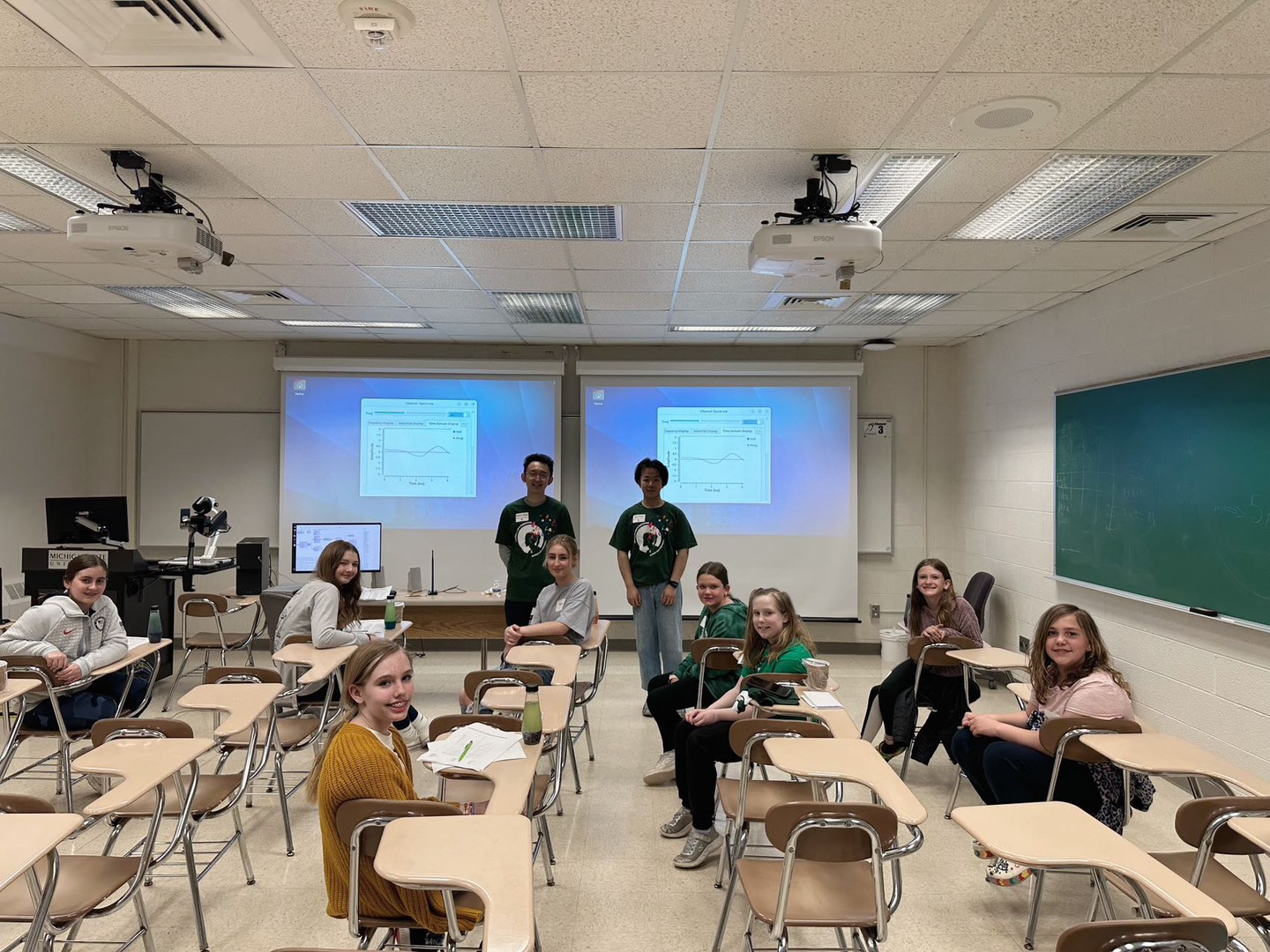
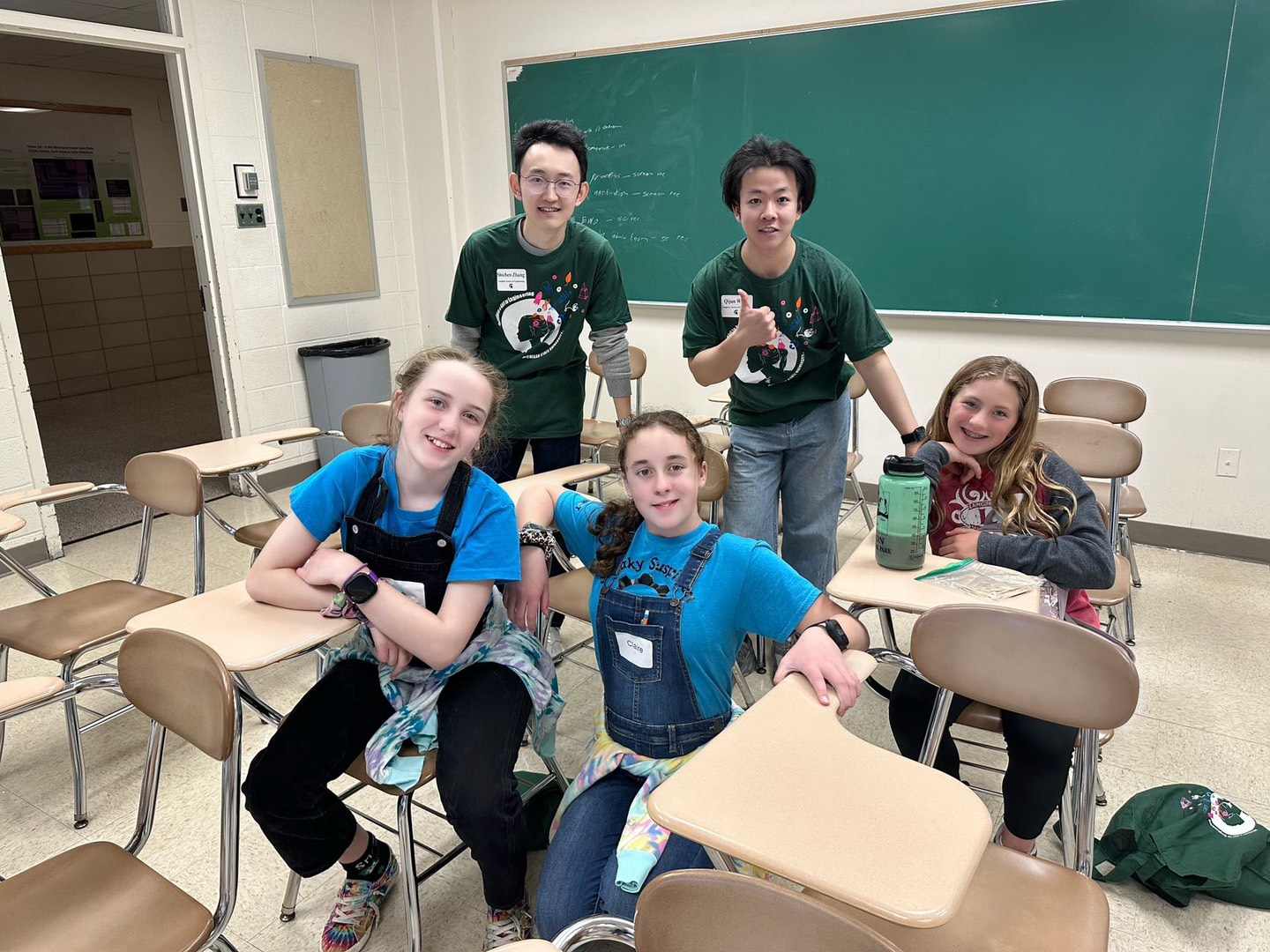
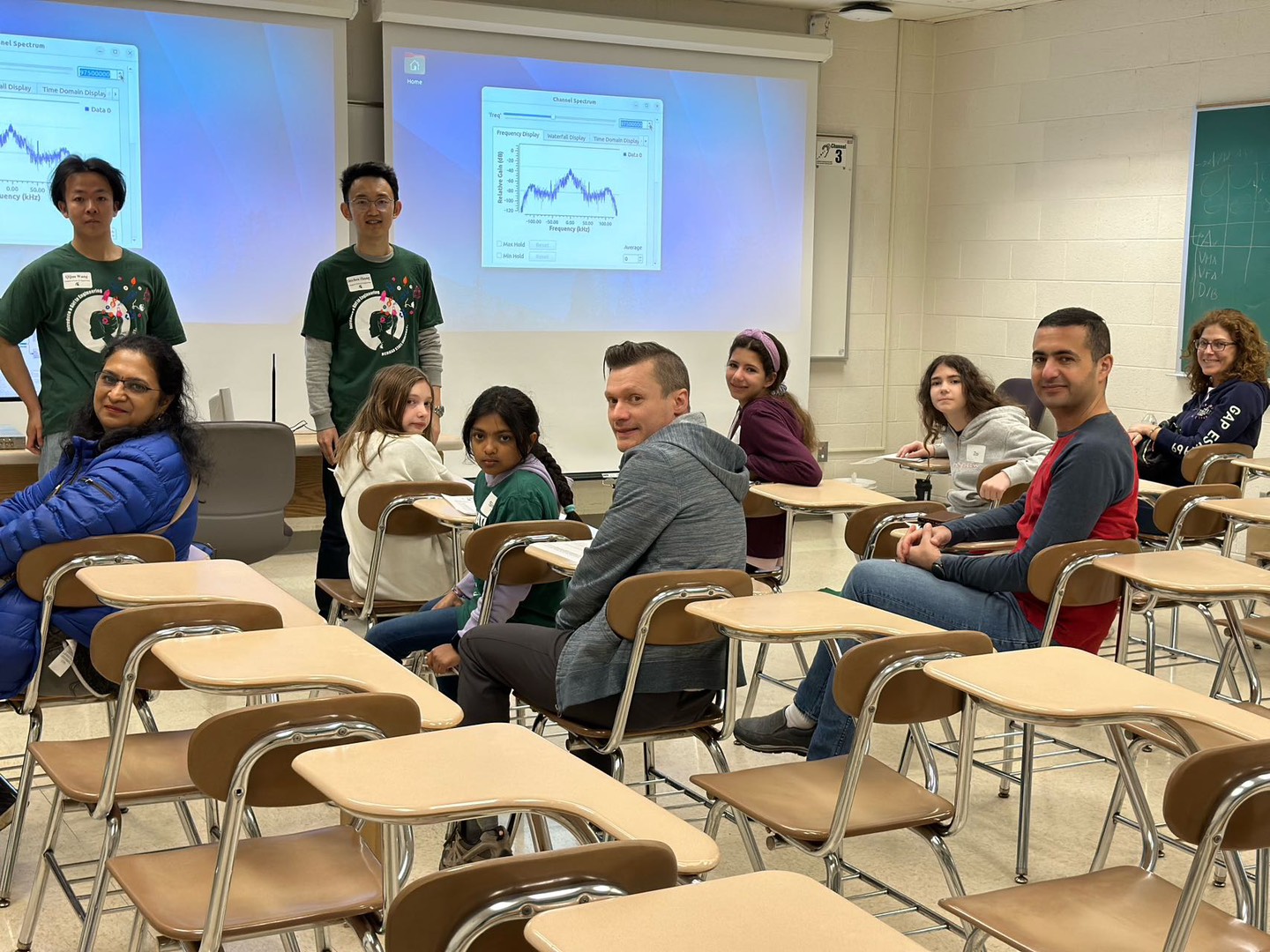
Year 5 – PI Zeng has hosted undergraduate research on Bluetooth device tracking:
This project hosted an undergraduate research project for Brendan Bushbaker (an undergraduate student in the Department of Computer Science at Michigan State University). He learned Bluetooth communication protocols and signal processing pipeline in this project. The developed a website to track any Bluetooth devices (e.g., iPhone, iPad, smart watch, and EarPods) in the proximity of our custom-designed sensors. In the website, end users can access the information of Bluetooth device location and tracking. The screenshot of the website from this undergraduate research project can be found below.
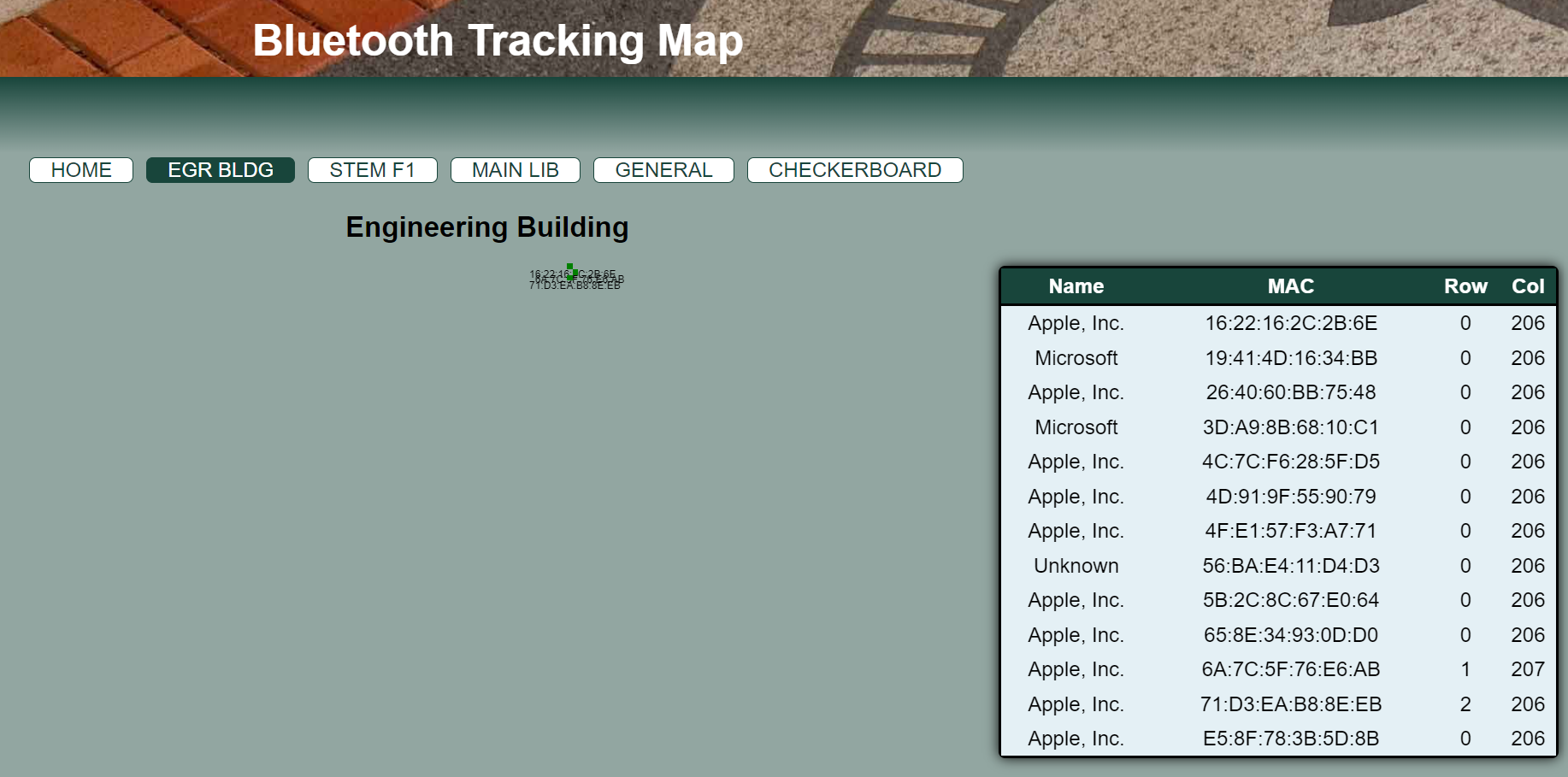
Year 5 – PI Zeng has given talk on smart device tracking to undegraduate
students at UDC (HBCU): PI Zeng gave a talk on “Location privacy risk of 5G smart devices” to the undergraduate students in the Department of Computer Science and Information Technology at the University of the District of Columbia, which is one of the Historically Black Colleges and Universities (HBCUs). During the talk, PI Zeng introduced the communication protocols and signal structure of smart devices such as smart watches, EarPods, phones, and smart glasses. Then, he demonstrated that without any modification on the smart devices, those smart devices can be tracked by leveraging the radio signals emitted by those devices. Students also learned how to use machine learning algorithms to improve the accuracy of device location and tracking in a large area, as well as the potential security threats poised by illegitimate tracking systems.
Year 4 – Undergraduate student works on antenna fabrication for interference mitigation
In this period, we hosted an undergraduate student to work on the antenna design and fabrication for our wireless communication systems. The student first designed the 6GHz patch antenna using HFSS software. The patch antenna has 4x4 patches in total. The student studied the frequency response of this antenna and performed simulation to verify his design. The student then ordered a ROGERS board sample for the antenna fabrication. He used the MSU ECE laboratory to make the patch antenna on the ROGERS BOARD.
Year 4: Host Hands-on Engineering Activities for MSU Girls’ Days
The PI and two graduate students working on this project participated in MSU Girls’ Days to offer hands-on engineering activities for 4th-8th girls, with the aim of attracting female students to pursue an engineering degree and career. We hosted a demo booth in the MSU Engineering Building and attracted a number of middle-school female students from the Okemos and East Lansing areas. We taught them to use GNU RADIO (software) and software-defined radio devices (hardware) to build an FM radio receiver. We instructed them on how to customize the GUI, how to adjust the parameters, and how to connect software with hardware.
Year 3 – Engage undergraduate students in research
This project provided a training opportunity to an undergraduate student in the Department of Computer Science and Engineering at Michigan State University. This student worked on the measurement and analysis of wireless cellular signals from an on-call smartphone, with the aim of identifying the data traffic pattern from an active cellphone and the signal features in the spatial domain. This student learned how to use software-defined ratio devices such as USRP to collect wireless signals from an active phone; he also learned how to use open-source software such as GNU Radio to develop the tools for radio signal collection. He participated in a research project, titled “Mitigating interference for cellular networks,” in which he was exposed to wireless system design and implementation. This student will continue his research in the next reporting period of this project.
Year 2 – The outreach activities were cancelled due to the COVID-19 pandemic
Year 1 – Engage undergraduate students in research
This project has hosted an independent study for a senior-year undergraduate student in the Department of Electrical and Computer Engineering at the University of Louisville. This student was working with Dr. Zeng on FPGA-based wireless receiver design and implementation to enable jamming-resilient Wi-Fi communications. His work has led to an award of $2,500 from the University of Louisville NSF I-Corps Site program.
Year 1 – Train high-school teachers in research via RET Site program
In the summer of 2019, PI hosted two high-school teachers (Mr. Steven Martell and Ms. Jessica Elliott from Henry County High School at Louisville) to learn wireless networking and big data technologies for six weeks. The two teachers were fully exposed to our research projects and group meetings. They have extended the knowledge gained in this project to their classrooms and passed their knowledge to high-school students. More information can be found here.
Demonstration of Wireless System Implementation
Practical Spectrum Sharing Solution for Real-World Wireless Systems
As the proliferation of mobile devices has led to an ever-growing demand for wireless Internet services, the spectrum shortage issue becomes increasingly severe and spectrum sharing is regarded as a promising approach to addressing the spectrum shortage issue. In research project, we proposed a practical underlay spectrum sharing scheme for cognitive radio networks (CRNs) where the primary users are oblivious to the secondary users. The key components of our scheme are two MIMO-based interference cancellation (IC) techniques to handle cross-network interference on the secondary network side. The first one is a blind beamforming technique for secondary transmitters. This IC technique allows a secondary transmitter to nullify its generated interference for primary users without requiring channel state information (CSI). The second one is a blind interference cancellation (BIC) technique for secondary receivers. This IC technique enables a secondary receiver to decode its desired signal in the presence of strong unknown interference from primary transmitters. Based on these two MIMO-based IC techniques, we develop a MAC protocol for the secondary network to enable underlay spectrum sharing in CRNs. We have implemented the proposed underlay spectrum sharing scheme on a GNURadio-USRP2 wireless testbed. Experimental results show that the secondary users can achieve an average of 1 bitsHz spectrum efficiency without degrading the performance of the primary users in a real-world office building environment.
Transparent Coexistence of WiFi and LTE
Spectrum sharing (a.k.a. coexistence) of heterogeneous wireless networks is considered as a promising solution to the spectrum shortage problem. Although many spectrum sharing schemes have been proposed to enable the coexistence of heterogeneous wireless networks, most of them require cross-network coordination and inter-network synchronization to be implemented in real-world wireless systems. In this project, we proposed a spectrum sharing scheme to enable transparent coexistence of WiFi and LTE networks. The enabler of our scheme is a blind interference cancellation technique, which is capable of decoding useful signal for a multi-antenna receiver in the presence of unknown (and strong) interference. We have built a prototype of our scheme on a SDR testbed and demonstrate its practicality in indoor wireless environments.
